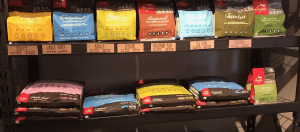Choosing the right dog food for your furry friend can be a daunting task, especially if you’re a new dog owner. With so many brands and types of dog food available, it’s easy to get overwhelmed and confused. However, it’s important to remember that not all dog food is created equal, and different breeds have different nutritional needs. In this article, we’ll guide you through the process of choosing the right dog food for specific breeds, so you can ensure that your dog is getting the nutrition they need to thrive.

When selecting dog food, it’s important to consider your dog’s breed, age, size, and activity level. Different breeds have different nutritional needs, and feeding your dog the wrong type of food can lead to health problems such as obesity, allergies, and digestive issues. For example, small breed dogs have faster metabolisms and require more calories per pound of body weight than larger breeds. On the other hand, large breed dogs are more prone to joint problems and require a diet that supports healthy bones and joints. By choosing a dog food that’s tailored to your dog’s specific needs, you can help prevent health issues and ensure that your dog stays healthy and happy.
In addition to considering your dog’s breed, it’s important to read the labels and ingredients list on dog food packaging. Look for high-quality protein sources, such as chicken, beef, or fish, as well as healthy fats and carbohydrates. Avoid dog foods that contain fillers, by-products, and artificial preservatives, as these can be harmful to your dog’s health. By taking the time to research and choose the right dog food for your furry friend, you can help them live a long, healthy life.
Understanding Dog Nutrition

Importance of Balanced Diet
A balanced diet is essential for a dog’s overall health and well-being. It is important to provide your dog with the right nutrients in the right amounts to ensure that they have the energy and nutrients they need to stay healthy. A balanced diet should include a mix of proteins, carbohydrates, fats, vitamins, and minerals.
Protein is essential for building and repairing tissues, while carbohydrates provide energy. Fats are important for maintaining healthy skin and coat, and vitamins and minerals are necessary for various bodily functions.
Role of Breed in Nutritional Needs
Different breeds have different nutritional needs based on their size, activity level, and other factors. For example, large breeds require more protein and calories than smaller breeds. Similarly, working dogs require more calories and protein than dogs that are less active.
It is important to choose a dog food that is specifically formulated for your dog’s breed and life stage. This will ensure that they are getting the right balance of nutrients to support their health and well-being.
When choosing a dog food, it is important to read the label and understand what ingredients are included. Look for foods that have high-quality proteins, whole grains, and vegetables. Avoid foods that contain fillers, artificial preservatives, and other additives that can be harmful to your dog’s health.
Remember, a healthy diet is an important part of keeping your dog happy and healthy. By understanding your dog’s nutritional needs, you can choose the right food to support their overall health and well-being.
Identifying Your Dog’s Specific Needs
When it comes to choosing the right dog food for your furry friend, it’s important to consider their specific needs. Here are some factors to keep in mind:
Age Considerations
Puppies have different nutritional needs than adult dogs, so it’s important to choose a food that is appropriate for their age. Look for puppy-specific formulas that are high in protein and fat to support their growth and development.
Senior dogs may also have different nutritional requirements, such as lower calorie and higher fiber diets to support their aging bodies. Speak to your vet for recommendations on what type of food is best for your senior dog.
Health Conditions
If your dog has a health condition such as allergies, digestive issues, or a medical condition, it’s important to choose a food that caters to their specific needs. For example, dogs with allergies may benefit from a limited ingredient diet, while dogs with digestive issues may benefit from a food that is easily digestible.
Always consult with your vet before making any changes to your dog’s diet, especially if they have a health condition.
Activity Level
Dogs with higher activity levels may require a food that is higher in protein and fat to support their energy needs, while less active dogs may require a food that is lower in calories to prevent weight gain.
Consider your dog’s daily activity level when choosing a food, and opt for a formula that matches their needs.
Remember, every dog is unique and may require different nutritional needs. Always consult with your vet before making any changes to your dog’s diet to ensure they are getting the proper nutrition they need.
Exploring Different Types of Dog Food

Dry Food
Dry food, also known as kibble, is the most commonly used type of dog food. It is easy to store and has a long shelf life. Dry food is also more affordable than other types of dog food. However, not all dry foods are created equal. Some brands may contain fillers and artificial preservatives that are not good for your dog’s health.
When choosing dry food, look for brands that use high-quality ingredients and avoid fillers such as corn, wheat, and soy. It is also important to choose a formula that is appropriate for your dog’s age, size, and activity level.
Wet Food
Wet food, also known as canned food, is a good option for dogs who need more moisture in their diet. It is also a good choice for dogs who have trouble chewing or swallowing dry food. Wet food is usually more expensive than dry food and has a shorter shelf life.
When choosing wet food, look for brands that use high-quality ingredients and avoid fillers and artificial preservatives. It is also important to choose a formula that is appropriate for your dog’s age, size, and activity level.
Raw and Homemade Food
Raw and homemade food is becoming more popular among dog owners. This type of food can be more expensive and time-consuming to prepare, but many owners believe it is worth the effort. Raw and homemade food can be tailored to your dog’s specific needs and can be a good option for dogs with food allergies or sensitivities.
When preparing raw or homemade food, it is important to consult with a veterinarian or animal nutritionist to ensure that your dog is getting all the necessary nutrients. Raw food can also pose a risk of bacterial contamination, so it is important to handle and store it properly.
There are many different types of dog food to choose from. Each type has its own benefits and drawbacks, so it is important to choose a formula that is appropriate for your dog’s individual needs.
Choosing Food for Specific Breeds
Small Breeds
Small breeds, such as Chihuahuas and Yorkshire Terriers, have unique nutritional needs due to their small size and high metabolism. They require a diet that is high in protein and fat to maintain their energy levels. Look for dog foods that are formulated specifically for small breeds, as these will have the right balance of nutrients for your furry friend.
Medium Breeds
Medium breeds, such as Bulldogs and Cocker Spaniels, have different nutritional needs than small breeds. They require a diet that is lower in fat and higher in fiber to maintain a healthy weight. Look for dog foods that are formulated specifically for medium breeds, as these will have the right balance of nutrients for your furry friend.
Large Breeds
Large breeds, such as Great Danes and Mastiffs, have unique nutritional needs due to their size and weight. They require a diet that is lower in fat and higher in protein to maintain their muscle mass and joint health. Look for dog foods that are formulated specifically for large breeds, as these will have the right balance of nutrients for your furry friend.
Remember to always consult with your veterinarian before making any changes to your dog’s diet. They can recommend the best food for your specific breed and help you make informed decisions about your dog’s nutrition.
Reading and Understanding Food Labels
When shopping for dog food, it’s important to understand what’s in the food you’re buying. That’s where reading and understanding food labels comes in. Here are some things to look for:
Ingredients List
The ingredients list is where you’ll find all the ingredients in the dog food. Look for high-quality protein sources like chicken, lamb, or fish. Avoid dog foods that have a lot of fillers like corn, wheat, or soy. These ingredients are often used as cheap fillers and aren’t very nutritious for your dog.
Guaranteed Analysis
The guaranteed analysis tells you the minimum and maximum percentages of protein, fat, fiber, and moisture in the dog food. Look for a dog food that has a minimum of 18% protein and 5% fat. This will ensure that your dog is getting the nutrition they need.
Nutritional Adequacy Statement
The nutritional adequacy statement tells you whether the dog food is complete and balanced for your dog’s life stage. Look for a dog food that is labeled as “complete and balanced” for your dog’s life stage. This means that the dog food has the right balance of nutrients for your dog.
Feeding Guidelines
The feeding guidelines tell you how much to feed your dog based on their weight. Follow these guidelines to ensure that your dog is getting the right amount of food.
Calorie Content
The calorie content tells you how many calories are in a serving of dog food. This is important to know so that you can adjust your dog’s diet if they need to lose or gain weight.
By understanding what’s on a dog food label, you can make an informed decision about what to feed your dog.
Conclusion
Choosing the right dog food for your specific breed is essential in ensuring that your furry friend stays healthy and happy. By considering your dog’s age, size, activity level, and nutritional needs, you can make an informed decision when selecting a dog food brand.
Remember to always read the label and check the ingredients to ensure that the dog food you choose contains all the necessary nutrients your dog needs. Additionally, keep in mind that some breeds may require special diets due to health conditions or allergies.
Consulting with a veterinarian can also be helpful in determining the best dog food for your specific breed. They can provide recommendations based on your dog’s individual needs and help you make an informed decision.
By taking the time to choose the right dog food for your specific breed, you can help ensure that your furry friend lives a long and healthy life.
Ever since she was a child, Simi has had a profound love for dogs, a passion that has grown stronger with each passing year. She's had the joy of sharing her life with a diverse array of canine companions, each with their own unique personality and story. Her days are filled with walks, playful barks, and endless affection, making her an unmistakable dog enthusiast whose heart is as warm and welcoming as her furry friends

